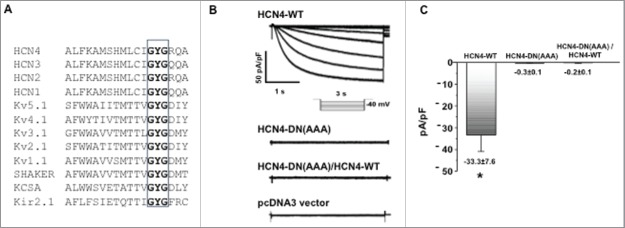
Figure 2. HCN4 dominant-negative effect test in HEK293 cells. (A) Sequence alignment of mouse HCN channels and other K+ channel examples that have a signature cation selectivity “GYG” motif at the channel pore region. (B) IHCN currents were elicited by a stepwise hyperpolarization to −120 mV from a holding potential of −40 mV; and then normalized to membrane capacitance. Representative IHCN4 current traces recorded in HEK293 cells expressing HCN4-WT, HCN4-DN(AAA) mutant, both HCN4-DN(AAA)/HCN4-WT, or a vector control are shown. Transfection with HCN4-WT produced robust IHCN4 currents, whereas transfection with HCN4-DN(AAA) did not produce any current greater than the vector control. When HCN4-WT and HCN4-DN(AAA) were co-transfected, IHCN4 was abolished. (C) Summary data for the peak IHCN4 currents recorded from HEK293 cells expressing WT-HCN4, HCN4-AAA mutant, HCN4-AAA/WT-HCN4 or vector control, confirming the ability of HCN4-DN(AAA) to act as a dominant-negative construct. n = 4–5, *p < 0.05.
Image published in: Pitcairn E et al. (2017)
© 2017 The Author(s). Creative Commons Attribution-NonCommercial-NoDerivatives license
Permanent Image Page
Printer Friendly View
XB-IMG-158048